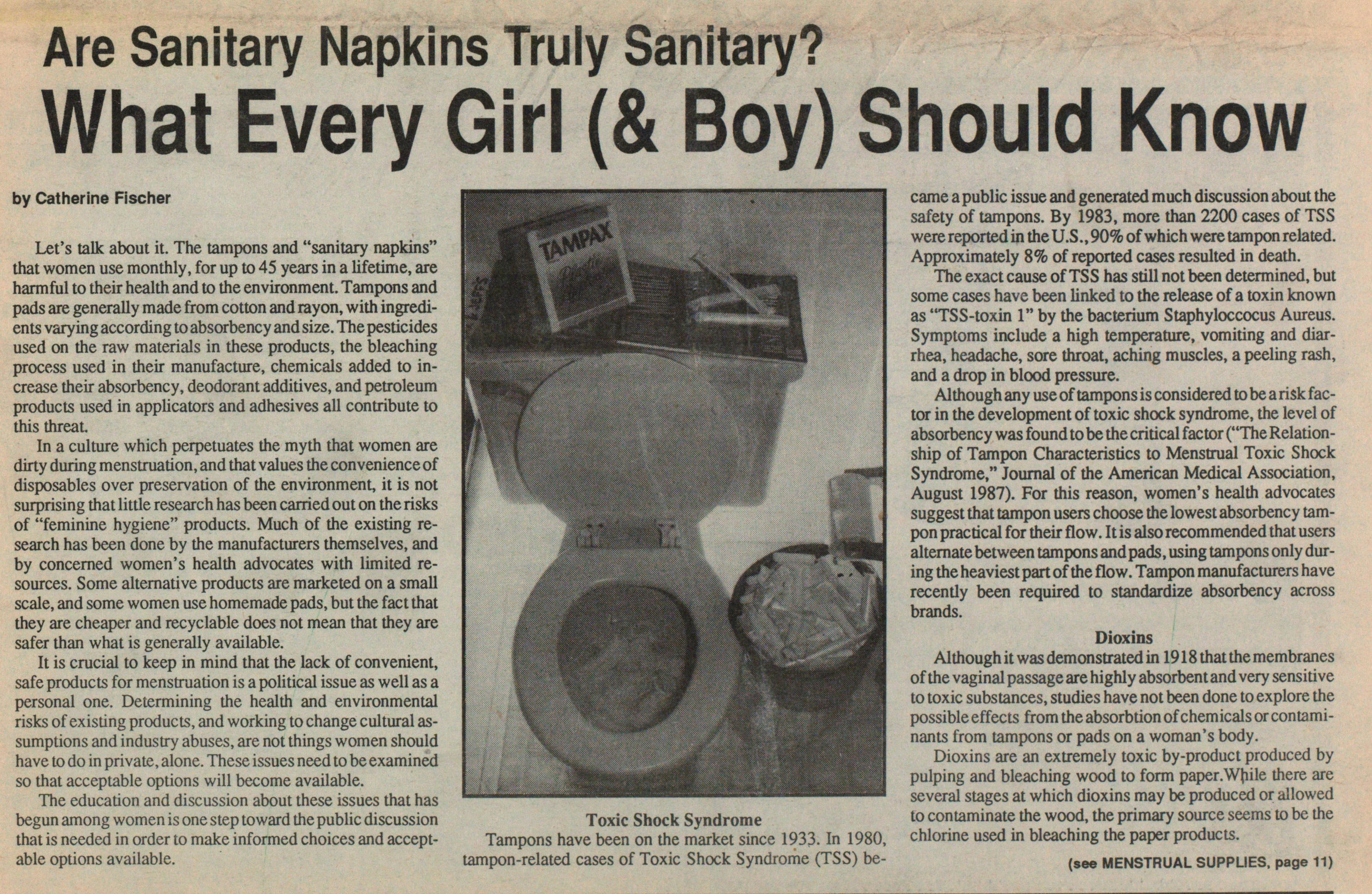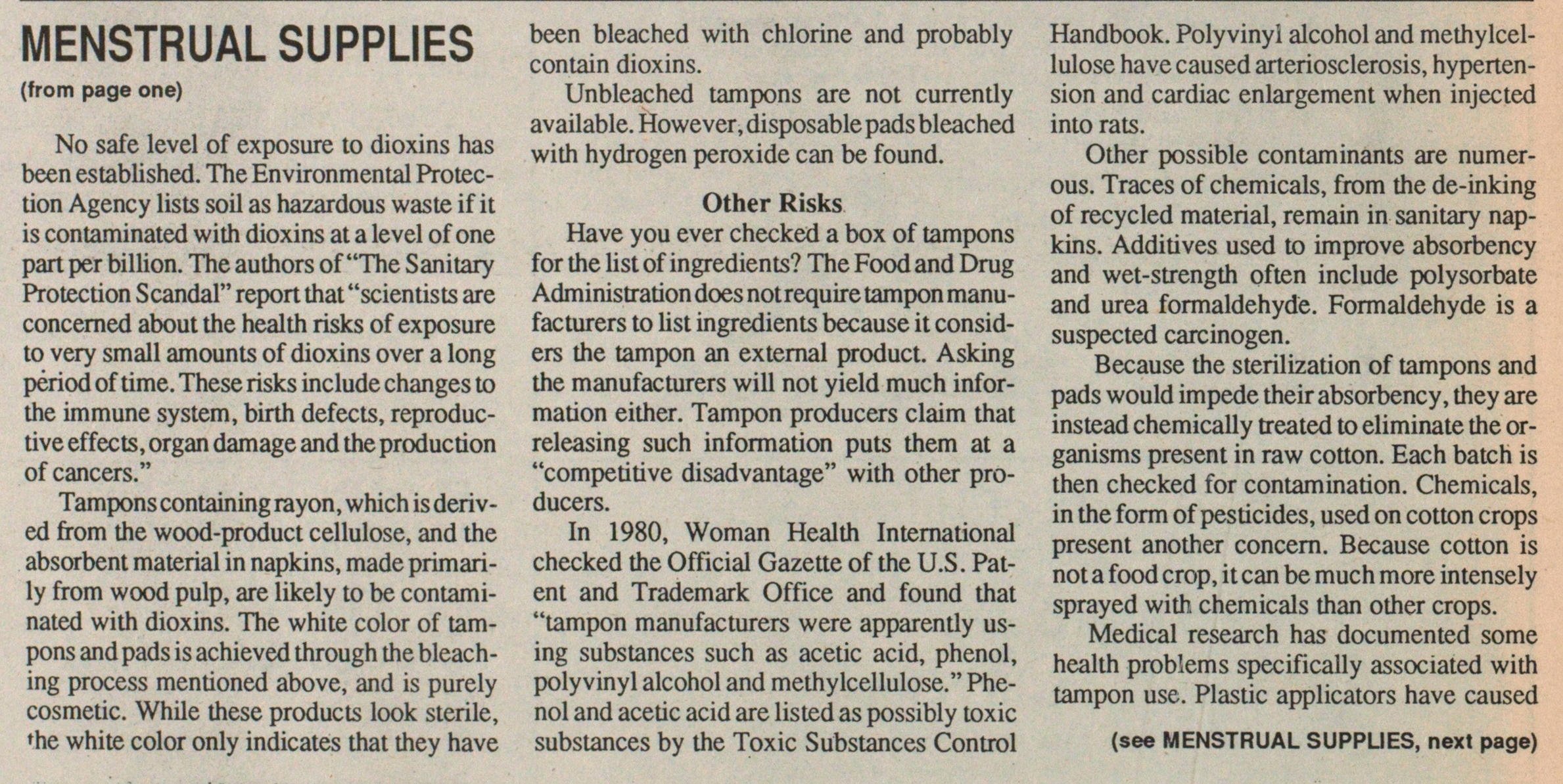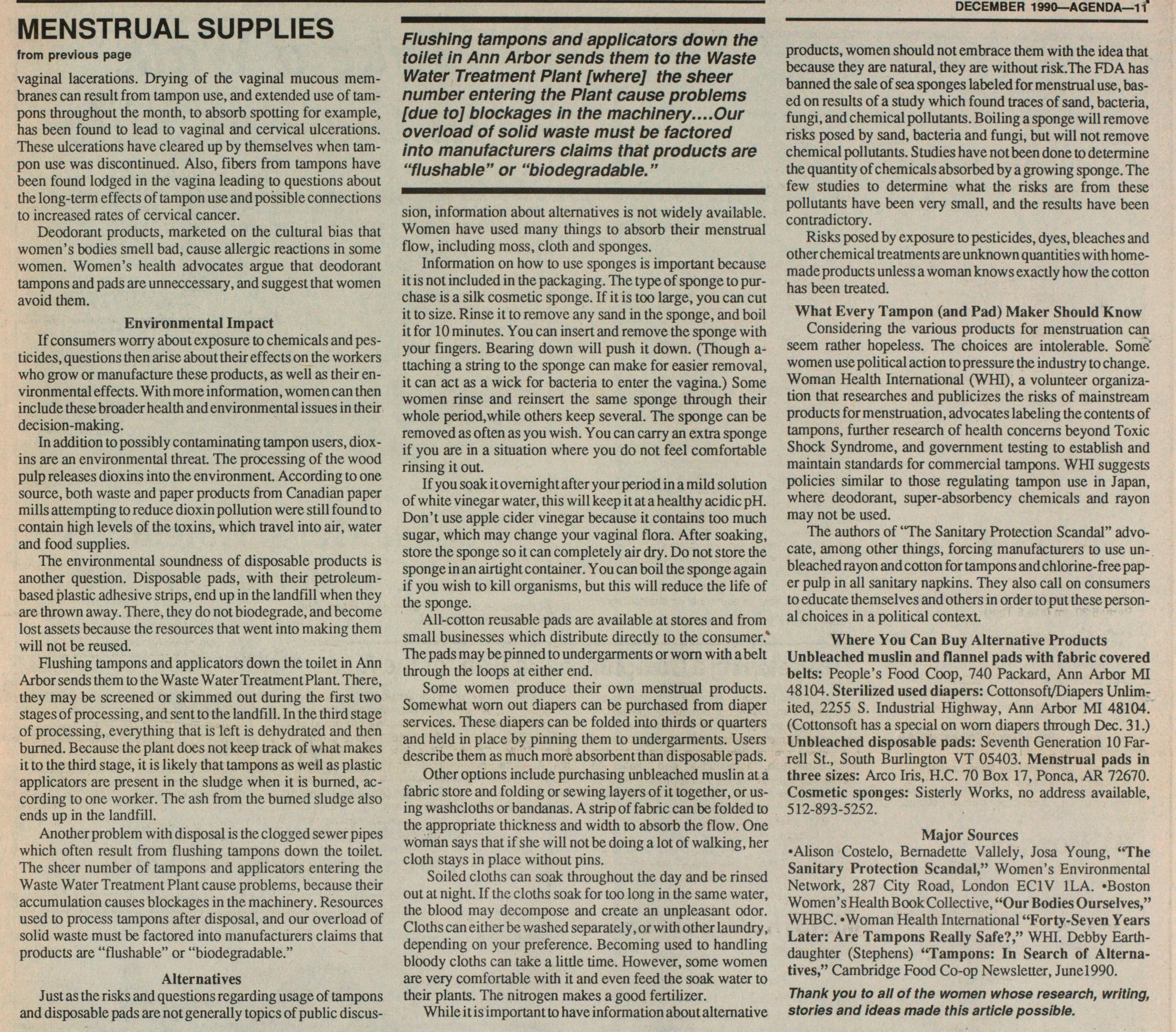Are Sanitary Napkins Truly Sanitary? What Every Girl (& Boy) Should Know



Are Sanitary Napkins Truly Sanitary?
What Every Girl (& Boy) Should Know
by Catherine Fischer
Let's talk about it. The tampons and "sanitary napkins" that women use monthly, for up to 45 years in a lifetime, are harmful to their health and to the environment. Tampons and pads are generally made from cotton and rayon, with ingredients vary ing according to absorbency and size. The pesticides used on the raw materials in these products, the bleaching process used in their manufacture, chemicals added to increase their absorbency, deodorant additives, and petroleum products used in applicators and adhesives all contribute to this threat.
In a culture which perpetuates the myth that women are dirty during menstruation, and that values the convenience of disposables over preservation of the environment, it is not surprising that little research has been carried out on the risks of "feminine hygiene" products. Much of the existing research has been done by the manufacturers themselves, and by concerned women's health advocates with limited resources. Some alternative products are marketed on a small scale, and some women use homemade pads, but the fact that they are cheaper and recyclable does not mean that they are safer than what is generally available.
It is crucial to keep in mind that the lack of convenient, safe products for menstruation is a political issue as well as a personal one. Determining the health and environmental risks of existing products, and working to change cultural assumptions and industry abuses, are not things women should have to do in private, alone. These issues need to be examined so that acceptable options will become available.
The education and discussion about these issues that has begun among women is one step toward the public discussion that is needed in order to make informed choices and acceptable options available.
Toxic Shock Syndrome
Tampons have been on the market since 1933. In 1980, tampon-related cases of Toxic Shock Syndrome (TSS) became a public issue and generated much discussion about the safety of tampons. By 1983, more than 2200 cases of TSS were reported in the U.S., 90% of which were tampon related. Approximately 8% of reported cases resulted in death.
The exact cause of TSS has still not been determined, but some cases have been linked to the release of a toxin known as "TSS-toxin 1" by the bacterium Staphyloccocus Aureus. Symptoms include a high temperature, vomiting and diarrhea, headache, sore throat, aching muscles, a peeling rash, and a drop in blood pressure.
Although any use of tampons is considered to be a risk factor in the development of toxic shock syndrome, the level of absorbency was found to be the critical factor ("The Relationship of Tampon Characteristics to Menstrual Toxic Shock Syndrome," Journal of the American Medical Association, August 1987). For this reason, women's health advocates suggest that tampon users choose the lowest absorbency tampon practical for their flow. It is also recommended that users alternate between tampons and pads, using tampons only during the heaviest part of the flow. Tampon manufacturers have recently been required to standardize absorbency across brands.
Dioxins
Although it was demonstrated in 1918 that the membranes of the vaginal passage are highly absorbent and very sensitive to toxic substances, studies have not been done to explore the possible effects from the absorbtion of chemicals or contaminants from tampons or pads on a woman's body.
Dioxins are an extremely toxic by-product produced by pulping and bleaching wood to form paper. While there are several stages at which dioxins may be produced or allowed to contaminate the wood, the primary source seems to be the chlorine used in bleaching the paper products.
No safe level of exposure to dioxins has been established. The Environmental Protection Agency lists soil as hazardous waste if it is contaminated with dioxins at a level of one part per billion. The authors of "The Sanitary Protection Scandal" report that "scientists are concerned about the health risks of exposure to very small amounts of dioxins over a long period of time. These risks include changes to the immune system, birth defects, reproductive effects, organ damage and the production of cancers."
Tampons containing rayon, which is derived from the wood-product cellulose, and the absorbent material in napkins, made primarily from wood pulp, are likely to be contaminated with dioxins. The white color of tampons and pads is achieved through the bleaching process mentioned above, and is purely cosmetic. While these products look sterile, the white color only indicates that they have been bleached with chlorine and probably contain dioxins.
Unbleached tampons are not currently available. However, disposable pads bleached with hydrogen peroxide can be found.
Other Risks
Have you ever checked a box of tampons for the list of ingredients? The Food and Drug Administration does notrequire tampon manufacturers to list ingredients because it considers the tampon an external product. Asking the manufacturers will not yield much information either. Tampon producers claim that releasing such information puts them at a "competitive disadvantage" with other producers.
In 1980, Woman Health International checked the Official Gazette of the U.S. Patent and Trademark Office and found that "tampon manufacturers were apparently using substances such as acetic acid, phenol, polyvinyl alcohol and methylcellulose." Phenol and acetic acid are listed as possibly toxic substances by the Toxic Substances Control Handbook. Polyvinyl alcohol and methylcellulose have caused arteriosclerosis, hypertension and cardiac enlargement when injected into rats.
Other possible contaminants are numerous. Traces of chemicals, from the de-inking of recycled material, remain in sanitary napkins. Additives used to improve absorbency and wet-strength often include polysorbate and urea formaldehyde. Formaldehyde is a suspected carcinogen.
Because the sterilization of tampons and pads would impede their absorbency, they are instead chemically treated to eliminate the organisms present in raw cotton. Each batch is then checked for contamination. Chemicals, in the form of pesticides, used on cotton crops present another concern. Because cotton is not a food crop, it can be much more intensely sprayed with chemicals than other crops.
Medical research has documented some health problems specifically associated with tampon use. Plastic applicators have caused vaginal lacerations. Drying of the vaginal mucous membranes can result from tampon use, and extended use of tampons throughout the month, to absorb spotting for example, has been found to lead to vaginal and cervical ulcerations. These ulcerations have cleared up by themselves when tampon use was discontinued. Also, fibers from tampons have been found lodged in the vagina leading to questions about the long-term effects of tampon use and possible connections to increased rates of cervical cancer.
Deodorant products, marketed on the cultural bias that women's bodies smell bad, cause allergic reactions in some women. Women's health advocates argue that deodorant tampons and pads are unneccessary, and suggest that women avoid them.
Environmental Impact If consumers worry about exposure to chemicals and pesticides, questions then arise about their effects on the workers who grow or manufacture these products, as well as their environmental effects. With more information, women can then include these broader health and environmental issues in their decision-making.
In addition to possibly contaminating tampon users, dioxins are an environmental threat. The processing of the wood pulp releases dioxins into the environment. According to one source, both waste and paper products from Canadian paper mills attempting to reduce dioxin pollution were still found to contain high levels of the toxins, which travel into air, water and food supplies.
The environmental soundness of disposable products is another question. Disposable pads, with their petroleumbased plastic adhesive strips, end up in the landfill when they are thrown away . There, they do not biodegrade, and become lost assets because the resources that went into making them will not be reused.
Flushing tampons and applicators down the toilet in Ann Arbor sends them to the Waste Water Treatment Plant. There, they may be screened or skimmed out during the first two stages of processing, and sent to the landfill. In the third stage of processing, everything that is left is dehydrated and then burned. Because the plant does not keep track of what makes it to the third stage, it is likely that tampons as well as plastic applicators are present in the sludge when it is burned, according to one worker. The ash from the burned sludge also ends up in the landfill.
Another problem with disposal is the clogged sewer pipes which often result from flushing tampons down the toilet. The sheer number of tampons and applicators entering the Waste Water Treatment Plant cause problems, because their accumulation causes blockages in the machinery. Resources used to process tampons after disposal, and our overload of solid waste must be factored into manufacturers claims that products are "flushable" or "biodegradable."
Alternatives
Just as the risks and questions regarding usage of tampons and disposable pads are not generally topics of public discussion, information about alternatives is not widely available. Women have used many things to absorb their menstrual flow, including moss, cloth and sponges. Information on how to use sponges is important because it is not included in the packaging. The type of sponge to purchase is a silk cosmetic sponge. If it is too large, you can cut it to size. Rinse it to remove any sand in the sponge, and boil it for 10 minutes. You can insert and remove the sponge with your fingers. Bearing down will push it down. (Though attaching a string to the sponge can make for easier removal, it can act as a wick for bacteria to enter the vagina.) Some women rinse and reinsert the same sponge through their whole period, while others keep several. The sponge can be removed as often as you wish. You can carry an extra sponge if you are in a situation where you do not feel comfortable rinsing it out.
If you soak it overnight after your period in a mild solution of white vinegar water, this will keep it at a healthy acidic pH. Don't use apple eider vinegar because it contains too much sugar, which may change your vaginal flora. After soaking, store the sponge so it can completely air dry. Do not store the sponge in an airtight container. You can boil the sponge again if you wish to kill organisms, but this will reduce the life of the sponge.
All-cotton reusable pads are available at stores and from small businesses which distribute directly to the consumer. The pads may be pinned to undergarments or worn with a belt through the loops at either end.
Some women produce their own menstrual products. Somewhat worn out diapers can be purchased from diaper services. These diapers can be folded into thirds or quarters and held in place by pinning them to undergarments. Users describe them as much more absorbent than disposable pads.
Other options include purchasing unbleached muslin at a fabric store and folding or sewing layers of it together, or using washcloths or bandanas. A strip of fabric can be folded to the appropriate thickness and width to absorb the flow. One woman says that if she will not be doing a lot of walking, her cloth stays in place without pins.
Soiled cloths can soak throughout the day and be rinsed out at night. If the cloths soak for too long in the same water, the blood may decompose and create an unpleasant odor. Cloths can either be washed separately, or with other laundry, depending on your preference. Becoming used to handling bloody cloths can take a little time. However, some women are very comfortable with it and even feed the soak water to their plants. The nitrogen makes a good fertilizer.
While it is important to have information about alternative products, women should not embrace them with the idea that because they are natural, they are without risk.The FDA has banned the sale of sea sponges labeled for menstrual use, based on results of a study which found traces of sand, bacteria, fungi, and chemical pollutants. Boiling a sponge will remove risks posed by sand, bacteria and fungi, but will not remove chemical pollutants. Studies have not been done to determine the quantity of chemicals absorbed by a growing sponge. The few studies to determine what the risks are from these pollutants have been very small, and the results have been contradictory.
Risks posed by exposure to pesticides, dyes, bleaches and other chemical treatments are unknown quantities with homemade products unless a woman knows exactly how the cotton has been treated.
What Every Tampon (and Pad) Maker Should Know
Considering the various products for menstruation can seem rather hopeless. The choices are intolerable. Some women use political action to pressure the industry to change. Woman Health International (WHI), a volunteer organization that researches and publicizes the risks of mainstream products for menstruation, advocates labeling the contents of tampons, further research of health concerns beyond Toxic Shock Syndrome, and government testing to establish and maintain standards for commercial tampons. WHI suggests policies similar to those regulating tampon use in Japan, where deodorant, super-absorbency chemicals and rayon may not be used.
The authors of 'The Sanitary Protection Scandal" advocate, among other things, forcing manufacturers to use unbleached rayon and cotton for tampons and chlorine-free paper pulp in all sanitary napkins. They also call on consumers to educate themselves and others in order to put these personal choices in a political context.
Where You Can Buy Alternative Products
Unbleached muslin and flannel pads with fabric covered belts: People's Food Coop, 740 Packard, Ann Arbor MI 48104. Sterilized used diapers: Cottonsoft/Diapers Unlimited, 2255 S. Industrial Highway, Ann Arbor MI 48104. (Cottonsoft has a special on worn diapers through Dec. 31.) Unbleached disposable pads: Seventh Generation 10 Farrell St., South Burlington VT 05403. Menstrual pads in three sizes: Arco Iris, H.C. 70 Box 17, Ponca, AR 72670. Cosmetic sponges: Sisterly Works, no address available, 512-893-5252.
Major Sources
Alison Costelo, Bernadette Vallely, Josa Young, "The Sanitary Protection Scandal," Women's Environmental Network, 287 City Road, London EC1V 1LA.
Boston Women's Health BookCollective, "Our Bodies Ourselves," WHBC.
Woman Health International "Forty-Seven Years Later: Are Tampons Really Safe?," WHI. Debby Earthdaughter (Stephens)
"Tampons: In Search of Alternatives," Cambridge Food Co-op Newsletter, June 1990.
Thank you to all of the women whose research, writing, stories and ideas made this article possible.